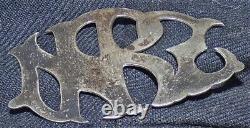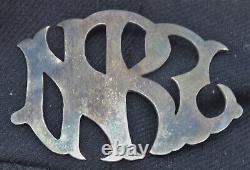N. Z. R. New Zealand RAILWAY Locomotive Driver's Uniform Cap Vintage RAILROAD HAT












The New Zealand GOVERNMENT Railway was for much of New Zealand's Railroad history a MONOPOLY. It was UNLAWFUL for TRUCKS to carry loads more than about 50 miles, distances any LONGER than that were required to be carried by TRAINS....... This old cap is in very good condition for its age. The Cap's BADGE appears to be SILVER (Pierced-out of Sheet-Silver by a local Jeweler) There are NO HALLMARKS to confirm that the badge is made of Silver. SIZE = 6 3/4 (British) = SMALL. Railway lines were initially constructed by the provincial governments of New Zealand from 1863 onwards. New Zealand's first public railway was opened in that year, running the short distance between Christchurch and the wharf at Ferrymead and built by the Canterbury Provincial Railways.
The Canterbury Provincial Railways were built to the broad gauge of 5 ft 3 in (1,600 mm). In February 1867, Southland Province opened a branch from Invercargill to Bluff to the international standard gauge of 4 ft 8+1?
2 in (1,435 mm). A Minister of Railways was responsible for the department and was a member of the New Zealand Cabinet. A few private companies built railways in New Zealand, including the New Zealand Midland Railway Company, Wellington and Manawatu Railway Company, Waimea Plains Railway, and Thames Valley and Rotorua Railway Company. One exception to this rule was the Ohai Railway Board in Southland, which was owned by the State Mines department and a local county council until its dissolution in 1990. The first major route was completed between Christchurch and Dunedin in 1878, later extended to Invercargill the following year.
The North Island Main Trunk, linking capital city Wellington with the largest city Auckland, opened in 1908 after 23 years of construction. At the network's peak in 1952, about 100 branch lines were operating. Large-scale closures of branch railway lines began in the 1960s and 1970s. The network was initially protected from road transport competition under the Transport Licensing Act 1931, but this protection was gradually eased until its total abolition in 1983, along with the deregulation of the land transport industry. The rail ferries operated by KiwiRail under the brand "Interisland Line" connect the networks of both the North and South Islands.The networks of the North and South Islands were independent of one another until the introduction of the inter-island roll-on roll-off rail ferry service in 1962 by the Railways Department, now branded The Interislander. Any questions please message me well before my listing's end-time. Add a map to your own listings.

